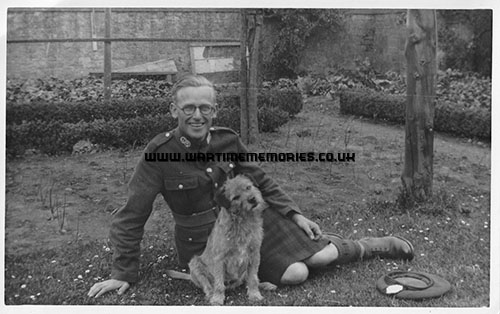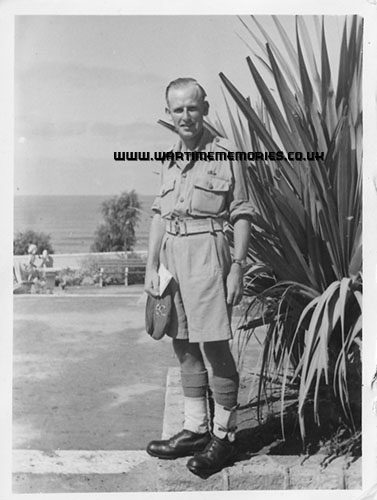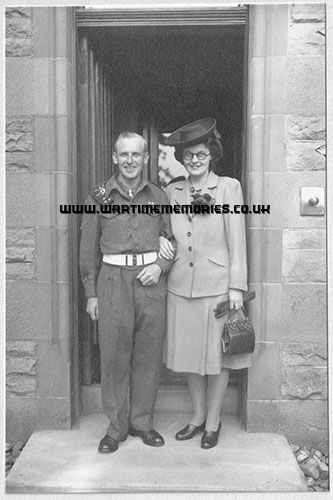|
|
|
6th Battalion, Argyll and Sutherland Highlanders
The 6th Battalion of The Argyll and Sutherland Highlanders were part of the British Expeditionary Force in 1940 and saw action in France and Belgium. In November 1941 they became the 93rd Anti-Tank Regiment, they then fought in Tunisia, Sicily and Italy with the 5th Corps of the 1st Army (sometimes known as the D-Day Dodgers).
23rd May 1940 In Action
24th May 1940 On the Move
15th of April 1945 Message
If you can provide any additional information, especially on actions and locations at specific dates, please add it here.
|
|
|
The Wartime Memories Project is the original WW1 and WW2 commemoration website.
Announcements

- 1st of September 2024 marks 25 years since the launch of the Wartime Memories Project. Thanks to everyone who has supported us over this time.
- The Wartime Memories Project has been running for 25 years. If you would like to support us, a donation, no matter how small, would be much appreciated, annually we need to raise enough funds to pay for our web hosting and admin or this site will vanish from the web.
- 26th Mar 2025 - Please note we currently have a huge backlog of submitted material, our volunteers are working through this as quickly as possible and all names, stories and photos will be added to the site. If you have already submitted a story to the site and your UID reference number is higher than
265607 your information is still in the queue, please do not resubmit, we are working through them as quickly as possible.
- Looking for help with Family History Research?
Please read our Family History FAQs
- The free to access section of The Wartime Memories Project website is run by volunteers and funded by donations from our visitors. If the information here has been helpful or you have enjoyed reaching the stories please conside making a donation, no matter how small, would be much appreciated, annually we need to raise enough funds to pay for our web hosting or this site will vanish from the web.
If you enjoy this site
please consider making a donation.
Want to find out more about your relative's service? Want to know what life was like during the War? Our
Library contains an ever growing number diary entries, personal letters and other documents, most transcribed into plain text. |
|
Wanted: Digital copies of Group photographs, Scrapbooks, Autograph books, photo albums, newspaper clippings, letters, postcards and ephemera relating to WW2. We would like to obtain digital copies of any documents or photographs relating to WW2 you may have at home. If you have any unwanted
photographs, documents or items from the First or Second World War, please do not destroy them.
The Wartime Memories Project will give them a good home and ensure that they are used for educational purposes. Please get in touch for the postal address, do not sent them to our PO Box as packages are not accepted.
World War 1 One ww1 wwII second 1939 1945 battalion
Did you know? We also have a section on The Great War. and a
Timecapsule to preserve stories from other conflicts for future generations.
|
|
Want to know more about 6th Battalion, Argyll and Sutherland Highlanders? There are:1324 items tagged 6th Battalion, Argyll and Sutherland Highlanders available in our Library There are:1324 items tagged 6th Battalion, Argyll and Sutherland Highlanders available in our Library 
These include information on officers, regimental histories, letters, diary entries, personal accounts and information about actions during the Second World War. |
|
Sgt. Alban Mather 6th Btn. Argyll & Sutherland Highlanders Alban Mather was born on the 1st April 1904 (although service records record this as 1906) in Preston, Lancashire. He was a labourer and stood a little over 5'4", weighing in at 126 lbs. He married Ada on the 3rd April 1937 and had four children: Marlene, Rose, Barbara, and Jean Alice. He lived at 72 Sussex Street in Preston.
He enlisted into Argyll and Sutherland Highlanders on the 23rd April 1928 in Preston. On the 11th November 1928, he was posted to the 1st Battalion. He was then posted to the 2nd Battalion in China on the 11th September 1929. Four years later, on the 12th December 1933, he moved with the Battalion to India, arriving on the 13th November. After serving on the Western Front in India for two years, he returned to the Depot where he was transferred to the Army Reserve on the 18th December 1935.
On the 5th of September 1939, Alban re-enlisted and was posted to the Argyll Depot in Sterling on the 7th. On the 9th he was posted to 2nd West Yorkshire Regiment at Aldershot. He was posted to 'A' Company, 6th Battalion, Argyll & Sutherland Highlanders, on the 26th November 1939. He then was attached to the 102nd Army Field Company, RE on the 8th March 1940.
The Battalion were stationed at Bordon and left by train at 10:55hrs on the 10th of January 1940 for Southampton. They arrived at 13:30hrs and immediately embarked on the SS Duke of York, sailing at 15:30hrs.The ship lay off Portsmouth until dark. The ship arrived in Cherbourg in convoy at 08:15hrs.
Alban served in France and Belgium with the 6th Battalion, who acted to control refugees. They took part in the withdrawal until instructed to help strengthen the defences along the Bassee Canal held by the 2nd Division. The Battalion were divided between the Brigades of the Division, with 'A' Company being attached to 5th Brigade and covering the immediate area of La Bassee with the Royal Warwickshire Regiment, Dorsetshire Regiment, Queen’s Own Cameron Highlanders, and Worcestershire Regiment.
Alban didn't return to the UK until about 21st June 1940.
|
Pte. William Downie 8th Btn. Argyle and Sutherland Highlanders    William Downie is my father. He never spoke about the War except a little before his death when he suffered from loss of vision and dementia.
What I know is gleaned from his army records and from my mother after his death.
He joined up at Stirling Castle in 1939. He had been working for British Aluminium in Kinlochleven so went with the men from that area. He was twenty. He was sent to BEF in France 24th of April 1940 returning 16th of June 1940 having avoided capture, possibly from Le Havre.
He remained in the Scottish Borders from June 40 until 22nd of October 1942. It was here he met my mother, Elspet Jackson, at a fund raising fete in Ancrum. She said she fell in love with his smile. He managed to get word to her he was about to embark to North Africa. She travelled to Perth but couldn't find her way out of the station and was helped by two military police only to find him hiding under a lorry as he was obviously AWOL.
He sailed from Gourock and was with the 8th Army in North Africa, then Italy where he disembarked at Taranto. The only story he ever told was finding, in an Italian port, a Nairn fishing boat called The Highland Lassie, which had been owned by his family. He was delighted by the free lunch he got for telling the current owner the history of the boat.
He was transferred on 22nd of February 1944 to 6th Battalion, Seaforth Highlanders and was wounded in action on 12th of April 1944. He continued to serve with MEF until 5th of March 1945, then was in North Western Europe until 23rd of June 1946. Ten days leave allowed him to get married on VE Day in Nairn.
He was demobbed on 4th of July 1946, with an exemplary record and the rank of Cpl, but was recalled for training with the Camerons in 1951.
I now correspond with the grandson and his family with whom he was billeted, in Borsbeke, Belgium. He, then my mother, now me, have exchanged Christmas cards with the family since 1945. He said they were incredibly kind to him.
|
WO2. Peter Syme 93rd Anti Tank Regiment Royal Artillery (d.16th February 1944) Peter Syme served with the 6th Argyll & Sutherland Highlanders which converted to become 93rd Anti Tank Regiment. He lost his life on the 16th of February 1944 and is buried in the Caserta War Cemetery in Italy.
|
Pte. Francis Dennis Klapper 6th Btn. Argyll & Sutherland Highlanders My uncle Francis Klapper from Newcastle on Tyne joined the 6th Battalion of the Argyll & Sutherland Highlanders and was sent to France in January 1940, but was captured in Belgium in May that year and sent to Lamsdorf, Stalag VIIIB. He worked for a couple of Arbeitskommandos, one at Reigersfeld and one at Klausberg, working first on roads and then down a mine until on 22nd January 1945 they began the long march west and eventually came home.
While in the Klausberg camp, one of his colleagues Arthur Lewis died in a coal fall at the Niederbank mine and Dennis went to his funeral. Among my uncle's papers there is a photograph of the grave of Arthur Lewis, and I wonder if his family have seen this or knew about it. I would be more than happy to let any family members have this photo.
|
Pte. Francis Dennis Klapper 6th Btn. Argyle & Sutherland Highlanders My uncle, Dennis Klapper was the grandson of Raymond Klapper. While serving in WWII he kept a diary from the beginning of 1940 to the end of 1945. This time frame includes the time of his capture by the Germans until his release and the end of the war. During his capture Dennis was kept in the infamous prison camp Stalag VIIIB which was located in Lamsdorf, Silesia which is now Lambinowice, Poland. By coincidence, this camp was located only a short distance from Cieplowody, Poland in Silesia where his family originally lived before coming to the UK in 1860.
Dennis was only 18 when he joined the 6th Battalion of the Argyle & Southern Highlanders. He was captured. The following is an exerpt from his diary:
1940
On January 4th we left Border for Southampton where we caught the boat for Cherbourg. From here after days of travelling we arrived at Armentieres where we stayed for a few weeks, then we moved to a village by the name of Auberchicourt near Douai where we remained until May 10th.
May 10th. Planes in morning, several shot down. Heard Germans invaded Belgium and Holland. Douai bombed. Stand to. Away in afternoon. Passing through Orchies, bombed. Took billets in Lessines for refugee control duties. Not much sleep. Crowds of refugees. Parachutists. Saw one or two air battles. 11 platoon got full load when German tried to gain height, four killed. Lessines bombed first morning. Church and shops gutted. Next week set off through Habsolth to wood. Shelled and bombed. Ammunitions truck went up. Champagne. Retreat to Lessines, through Engaden in flames. then for rest in a village. Bombed as we left. Next to Grammont to cover withdrawal. Next day set off for France. Roads bombed and gunned. Lost two trucks and two men. Refugees killed. Rest near Orchies. Back to Brumes as reserve coy; down to Douai for armoured units. Brumes to cover withdrawal on way to rest-camp, turned back to front near Gavion then to farm near Bethune for two days rest. Pleinar gunned and shelled.
May 25th. Set off for Bethune, just bombed. Driving down road, were machine gunned and shelled. Lorries in ditches. Radiator damaged. Dived in ditch with two other fellows. One on truck hit by mortar. Tried to crawl along ditch but blocked at one end and truck on side, blazing at other. Own guns used on us. Captured. Got some soup, bread, marge, cheese. Drome with planes. Heard Gray killed and Graham escaped. Officer said they had been waiting all morning for us. Shed for night, coffee in morning.
Dennis then keeps a (nearly) daily diary until 15th June 1942. He was taken to Stalag VIIIB, a camp known as Lamsdorf.
“There were more than 700 subsidiary Arbeitskommandos (working parties outside the main camp)…
Arbeitskommandos housed the lower ranks who were working in coal mines, factories, quarries or on the railways.
He was moved from Lamsdorf in July 1940 (in a closed wagon on a train) to a camp at Reigersfeld and sent to work on road and canal building and was then taken by horse truck in very cold weather with other POWs in January 1941 from the camp at Reigersfeld, to Klausburg, a coal mining camp. From now until the camp was evacuated in 1945 he was to work in the mines. He seems to have remained at Klausberg until the camp was evacuated and he took part in the `Long March' in January 1945: this was a forced march by an estimated 80,000 POWs westward across Poland, Czechoslovakia and Germany in extreme winter conditons between January and April 1945.
He wrote an account of his experiences on the Long March, in the course of which he lost toes to frostbite. Dennis also contracted TB in the camps, he was invalided home because of his lungs (aggravating or being aggravated by malnutrition) more so than the frostbite. Dennis became a postman in Gateshead and died unmarried in 1987. He never recovered from his experiences.
|
L/Bdr. James H. Walker 93 Anti-Tank Regiment Royal Artillery (d.21st Feb 1943) James Walker was the son of James Henry and Sarah Walker and husband of Ann McGreal Walker of Jarrow. He died aged 28 and is buried in Enfidaville War Cemetery. He is commemorated on the WW2 Roll of Honour Plaque in the entrance of Jarrow Town Hall.
|
Recomended Reading.Available at discounted prices.
|
|
|







